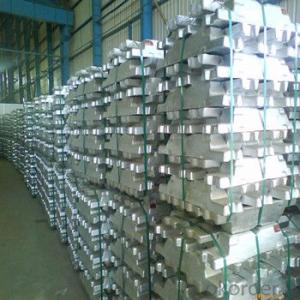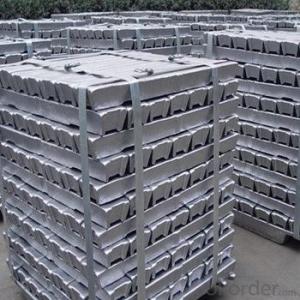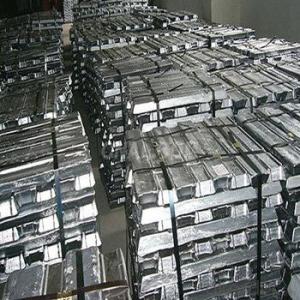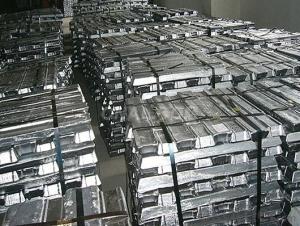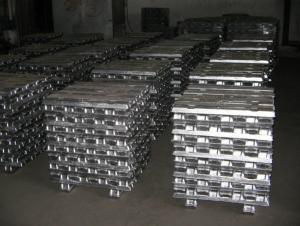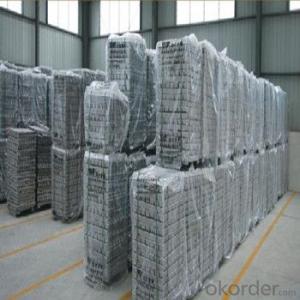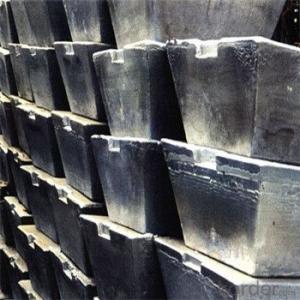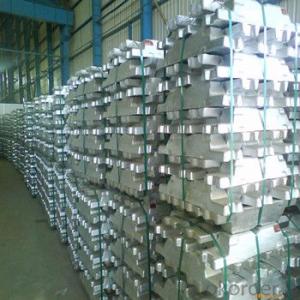Aluminium Ingot with Good Price and Hot Sale for the Markets
- Loading Port:
- China main port
- Payment Terms:
- TT or LC
- Min Order Qty:
- 1000 m.t.
- Supply Capability:
- 10000 m.t./month
OKorder Service Pledge
OKorder Financial Service
You Might Also Like
Pure Aluminum Ingot Used for Industry
1.Structure of Aluminum Ingot Description
Aluminum Ingot is with the AL as the main chemical composition. Aluminum Ingot is used for industry,such as automobile,pinning and weaving,electron broadly and so on. Aluminum Ingot has the following advantages: easy control and operation, fast melting.
2.Main Features of the Aluminum Ingot
•High Purity
•Easy control and operation
•High strength
•Fast melting
•Competitive price
•Best Service
3. Aluminum Ingot Images

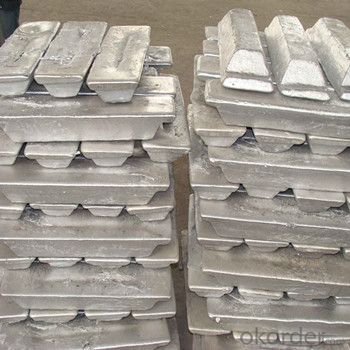
4. Aluminum Ingot Specification
Grade | Chemical Composition % | |||||||||
Al≥ | impurities ≤ | |||||||||
Si | Fe | Cu | Ga | Mg | Zn | Mn | others | Sum | ||
Al99.9 | 99.90 | 0.50 | 0.07 | 0.005 | 0.02 | 0.01 | 0.025 | - | 0.010 | 0.10 |
Al99.85 | 99.85 | 0.80 | 0.12 | 0.005 | 0.03 | 0.02 | 0.030 | - | 0.015 | 0.15 |
Al99.7 | 99.70 | 0.10 | 0.20 | 0.010 | 0.03 | 0.02 | 0.030 | - | 0.030 | 0.30 |
Al99.6 | 99.60 | 0.16 | 0.25 | 0.010 | 0.03 | 0.03 | 0.030 | - | 0.030 | 0.40 |
Al99.5 | 99.50 | 0.22 | 0.30 | 0.020 | 0.03 | 0.05 | 0.050 | - | 0.030 | 0.50 |
Al99.00 | 99.00 | 0.42 | 0.50 | 0.020 | 0.03 | 0.05 | 0.050 | - | 0.050 | 1.00 |
5.FAQ of Aluminum Ingot
We have organized several common questions for our clients,may help you sincerely:
①How about your company?
A world class manufacturer & supplier of castings forging in carbon steel and alloy steel,is one of the large-scale professional investment casting production bases in China,consisting of both casting foundry forging and machining factory. Annually more than 8000 tons Precision casting and forging parts are exported to markets in Europe,America and Japan. OEM casting and forging service available according to customer’s requirements.
②How to guarantee the quality of the products?
We have established the international advanced quality management system,every link from raw material to final product we have strict quality test;We resolutely put an end to unqualified products flowing into the market. At the same time, we will provide necessary follow-up service assurance.
③How long can we receive the product after purchase?
In the purchase of product within three working days, We will arrange the factory delivery as soon as possible. The pecific time of receiving is related to the state and position of customers.Commonly 7 to 10 working days can be served.
- Q:How much is the power consumption to smelt a ton of aluminium ingot?
- Plus you want to formula to aluminum alloy brand, higher temperature, and insulation process, estimated 700-800 degrees of electricity; processing into aluminum plate must be 1000 degrees electricity.
- Q:How are aluminum ingots used in the production of household appliances?
- Aluminum ingots are used in the production of household appliances as they can be easily molded into various shapes and sizes. They are commonly used to make the outer casings and frames of appliances such as refrigerators, ovens, and washing machines due to their lightweight, durable, and corrosion-resistant properties. Additionally, aluminum ingots are also used in the production of heat sinks and electrical components within appliances to dissipate heat efficiently and ensure optimal performance.
- Q:What are the advantages of using recycled aluminum ingots?
- There are several advantages of using recycled aluminum ingots: 1. Environmental benefits: Recycling aluminum requires significantly less energy compared to extracting it from its raw form. By using recycled aluminum ingots, we can reduce energy consumption and greenhouse gas emissions. Additionally, recycling aluminum helps in conserving natural resources and reducing the need for mining, which can have negative environmental impacts. 2. Cost-effective: Using recycled aluminum ingots can be cost-effective in the long run. Recycling aluminum requires less energy and resources compared to producing new aluminum, leading to lower production costs. This cost-effectiveness can be passed on to consumers, making recycled aluminum products more affordable. 3. Reduced waste: By recycling aluminum, we can divert a significant amount of waste from landfills. Aluminum is a highly recyclable material, and recycling it reduces the need for disposal and the associated costs. Additionally, recycling aluminum prevents the accumulation of aluminum waste, which can take hundreds of years to decompose. 4. Energy savings: Producing aluminum from recycled ingots requires only a fraction of the energy required to produce it from raw materials. Recycling aluminum saves up to 95% of the energy compared to primary production, making it an energy-efficient choice. This energy saving also translates into a reduction in carbon emissions. 5. Positive impact on the economy: The recycling industry plays a significant role in job creation and economic growth. By using recycled aluminum ingots, we support the recycling industry and contribute to local economies. Additionally, using recycled aluminum reduces dependence on imported raw materials, which can have economic benefits for countries. 6. Versatility and quality: Recycled aluminum ingots can be used to produce a wide range of products, just like primary aluminum. The quality of recycled aluminum is comparable to that of primary aluminum, making it suitable for various applications. Its versatility allows for the creation of high-quality, durable, and reliable products. Overall, using recycled aluminum ingots provides numerous advantages, including environmental benefits, cost-effectiveness, waste reduction, energy savings, positive economic impact, and the ability to produce high-quality products. It is an excellent choice for individuals and businesses looking to minimize their environmental footprint and contribute to a more sustainable future.
- Q:How to refine aluminum ingot
- Sales must not be a big problem, small and medium-sized aluminum factories will generally buy, but if you do not remove other components, and direct sell cans, there is no big difference in price.
- Q:How much is the price of the common aluminum sheet on the basis of the aluminum ingot? How much is the price of the broken aluminum alloy profile on the basis of the aluminum ingot?
- Ordinary aluminum cold rolling is about 2 or more thousand, hot rolling plus more than 3 thousand. Regular is within 4 meters long, 0.9-1.3 meters wide, more than 0.2 millimeters thick, special specifications but also additional money.If the section is too large, it's hard to say.
- Q:I would like to ask, aluminum water poured into the mold, what should pay attention to? Aluminum solidification in the mold after the aluminum ingot, how can I get it out?
- One side of the mold is generally provided with a push plate, and the two modules are connected by hinges, and the other end is provided with a clip to prevent the aluminum water from expanding into the cavity.
- Q:What are the energy requirements for producing aluminum ingots?
- The energy requirements for producing aluminum ingots can vary depending on several factors such as the type of production process, the source of energy used, and the efficiency of the production facility. However, generally, the production of aluminum ingots is an energy-intensive process. The primary method for producing aluminum ingots is through the smelting of aluminum oxide, or alumina, which is obtained from bauxite ore. The most common method used is the Hall-Héroult process, which involves the electrolysis of alumina dissolved in a molten cryolite electrolyte. In this process, a significant amount of energy is required to heat the alumina to its melting point of around 2,040 degrees Celsius and maintain it at this temperature. The energy is typically provided by large electric currents passed through the molten electrolyte, where the electrolysis takes place. Additionally, the production of aluminum ingots requires a substantial amount of electrical energy to break the chemical bonds in the alumina and separate the aluminum metal from the oxygen. The electrolysis process consumes a substantial amount of electricity, making aluminum production one of the largest consumers of electrical energy worldwide. The energy requirements for producing aluminum ingots can also be influenced by the source of electricity used. If renewable energy sources such as hydropower, wind power, or solar power are utilized, the environmental impact and carbon footprint of aluminum production can be significantly reduced. On the other hand, if the electricity is generated from non-renewable sources such as coal or natural gas, the energy requirements may be higher and contribute to higher greenhouse gas emissions. Efficiency improvements and technological advancements have been made in aluminum production processes over the years, leading to reductions in energy consumption. For example, the development of pre-baked anode technology has increased the energy efficiency of the Hall-Héroult process. Furthermore, recycling aluminum requires significantly less energy compared to primary production from bauxite ore, making it a more sustainable and energy-efficient option. In conclusion, the energy requirements for producing aluminum ingots are substantial due to the high temperatures required for the smelting process and the electricity needed for electrolysis. However, advancements in technology and the utilization of renewable energy sources can help reduce the energy consumption and environmental impact of aluminum production.
- Q:What is the role of aluminum ingots in the production of foils?
- Aluminum ingots play a crucial role in the production of foils. Foils are thin, flexible sheets made primarily from aluminum, which is known for its lightweight, strength, and corrosion-resistant properties. Aluminum ingots serve as the raw material for the manufacturing of foils. The process of producing foils begins with the melting of aluminum ingots. The ingots are heated to a high temperature, causing them to melt and transform into a liquid state. This liquid aluminum is then cast into thin slabs, which are subsequently rolled and reduced in thickness through a series of rolling mills. The aluminum ingots provide the necessary material for this rolling process. They are fed into the rolling mills, where they undergo continuous compression and elongation, transforming them into thin sheets with uniform thickness. The ingots act as the source of aluminum, ensuring a consistent supply of material throughout the rolling process. Aluminum ingots also determine the quality and characteristics of the resulting foils. The composition and purity of the ingots have a direct impact on the final product. High-quality ingots with low levels of impurities result in foils with excellent surface finish, superior strength, and enhanced resistance to corrosion. Furthermore, the size and dimensions of the aluminum ingots influence the size and dimensions of the foils produced. Larger ingots can yield wider and longer foils, while smaller ingots are suitable for narrower and shorter foils. In conclusion, aluminum ingots serve as the starting point and primary material for the production of foils. They are melted, cast, and rolled into thin sheets, providing the necessary aluminum for the manufacturing process. The quality, purity, and size of the ingots directly impact the quality and characteristics of the resulting foils, making them a critical component in the foil production industry.
- Q:What can aluminium ingots do?
- It is with the alumina cryolite produced by electrolysis. There are two major types of aluminum ingot after industrial application: cast aluminum alloy and wrought aluminum alloy.
- Q:What kind of aluminum consumption does the furnace compare with natural gas?
- The aluminum loss of the reverberatory furnace is proportional to the melting time: the longer the loss is, the higher the temperature of the flame, the aluminum surface continues to oxidize to alumina powder.
1. Manufacturer Overview |
|
|---|---|
| Location | |
| Year Established | |
| Annual Output Value | |
| Main Markets | |
| Company Certifications | |
2. Manufacturer Certificates |
|
|---|---|
| a) Certification Name | |
| Range | |
| Reference | |
| Validity Period | |
3. Manufacturer Capability |
|
|---|---|
| a)Trade Capacity | |
| Nearest Port | |
| Export Percentage | |
| No.of Employees in Trade Department | |
| Language Spoken: | |
| b)Factory Information | |
| Factory Size: | |
| No. of Production Lines | |
| Contract Manufacturing | |
| Product Price Range | |
Send your message to us
Aluminium Ingot with Good Price and Hot Sale for the Markets
- Loading Port:
- China main port
- Payment Terms:
- TT or LC
- Min Order Qty:
- 1000 m.t.
- Supply Capability:
- 10000 m.t./month
OKorder Service Pledge
OKorder Financial Service
Similar products
New products
Hot products
